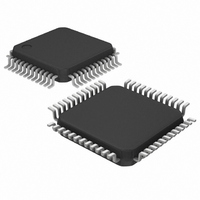MAXQ7667AACM/V+ Maxim Integrated Products, MAXQ7667AACM/V+ Datasheet - Page 16

MAXQ7667AACM/V+
Manufacturer Part Number
MAXQ7667AACM/V+
Description
IC MCU-BASED DAS 16BIT 48-LQFP
Manufacturer
Maxim Integrated Products
Series
MAXQ™r
Datasheet
1.MAXQ7667AACMV.pdf
(40 pages)
Specifications of MAXQ7667AACM/V+
Core Processor
RISC
Core Size
16-Bit
Speed
16MHz
Connectivity
LIN, SPI, UART/USART
Peripherals
Brown-out Detect/Reset, POR, WDT
Number Of I /o
16
Program Memory Size
32KB (16K x 16)
Program Memory Type
FLASH
Ram Size
2K x 16
Voltage - Supply (vcc/vdd)
2.25 V ~ 2.75 V
Data Converters
A/D 5x12b
Oscillator Type
Internal
Operating Temperature
-40°C ~ 125°C
Package / Case
48-LQFP
Processor Series
MAXQ7667
Core
RISC
Data Bus Width
16 bit
Data Ram Size
4 KB
Interface Type
UART, JTAG, LIN
Maximum Clock Frequency
16 MHz
Number Of Programmable I/os
16
Number Of Timers
3
Operating Supply Voltage
5 V
Maximum Operating Temperature
+ 125 C
Mounting Style
SMD/SMT
Development Tools By Supplier
MAXQ7667EVKIT
Minimum Operating Temperature
- 40 C
On-chip Adc
12 bit, 5 Channel
Lead Free Status / RoHS Status
Lead free / RoHS Compliant
Eeprom Size
-
Lead Free Status / Rohs Status
Details
16-Bit, RISC, Microcontroller-Based,
Ultrasonic Distance-Measuring System
The ultrasonic distance-measurement peripherals in the
MAXQ7667 include a burst signal generator for
acoustic transmission and mixed signal circuits for
amplifying and digitizing echo signals ranging between
25kHz and 100kHz. The burst signal is a square wave
with adjustable duty cycle and pulse count. The burst is
derived either directly from the system clock or from a
programmable PLL locked to the system clock. The
MAXQ7667 effectively digitizes the echo signals
received at the ECHOP and ECHON inputs using an
LNA, sigma-delta ADC with variable analog gain ampli-
fier, noise-limiting digital bandpass filter, digital full-
wave rectifier, and a digital lowpass filter (see the
Typical Application Circuit/Functional Diagram ). The
device detects echo signals at the burst frequency with
amplitudes ranging from 10µV
greater than 100mV
ly clipped but do not saturate the receiver. To optimize
echo reception, the clock used for processing the echo
locks to the burst frequency. The MAXQ7667’s burst
generator can generate higher frequencies, but the
maximum usable frequency for the echo receive path is
100kHz . For applications requiring transducer frequen-
cies above 100kHz, implement an external echo
receive path. The SAR ADC can then digitize the fil-
tered echo envelope.
An integrated 16-bit RISC µC (MAXQ20) provides tim-
ing control, signal processing, and data I/O. The 16-bit
Harvard architecture RISC core executes most instruc-
tions in a single clock cycle from instruction fetch to
cycle completion. The MAXQ20 provides optimal per-
formance for noise-sensitive analog applications.
Figure 1. Burst Transmission Stage
16
24kΩ
33nF
R1
C1
______________________________________________________________________________________
C2
330pF
FILT
(f
P-P
SYSTEM
CLOCK
SYSCLK
PLLF[10:9]:PLLC[1:0]
Detailed Description
and less than 2V
)
BTRN[15:12]:BDIV[3:0]
PLL
PLLF[8:0]
P-P
to 100mV
BTRN.10:BCKS
1
0
P-P
are internal-
P-P
. Echoes
BPH[9:0]
RECEIVE CLOCK
BURST CLOCK
GENERATOR
PRESCALE
BTRN[7:0]:BCNT[7:0]
MAXQ7667
The MAXQ7667 includes a 13.5MHz RC oscillator,
external crystal oscillator, watchdog timer, schedule
timer, three general-purpose Type 2 timers/counters,
two 8-bit GPIO ports, SPI interface, JTAG interface, LIN
capable UART interface, 12-bit SAR ADC with five mul-
tiplexed input channels, supply-voltage monitors, and a
voltage reference for communication, diagnostics, and
miscellaneous support.
The MAXQ7667 provides a square-wave burst signal at
the BURST output. Use the burst control to transmit an
ultrasonic signal. Typical applications use the burst sig-
nal to switch an external transistor that drives a high-
voltage transformer, which excites the transducer (see
the Typical Application Circuit/Functional Diagram ).
Use software to configure the duty cycle, frequency,
number of pulses, and drive current of the burst. See
Section 17 of the MAXQ7667 User’s Guide .
Derive the burst signal either directly from the system
clock or from a programmable oscillator phase locked
to the system clock (Figure 1). Using the system clock
limits the burst frequency to one of 16 choices. Integer
division of the system clock generates these 16 fre-
quencies. The PLL allows a fractional division of the
system clock. Any frequency within the PLL range is
selectable to a resolution of 0.13% or better.
When using the internal PLL, connect external filter
components (C1, R1, and C2) to FILT as shown in
Figure 1. These components filter the analog voltage
that controls the VCO in the PLL. The filter component
values shown in the figure are suitable for the entire
PLL frequency range.
BPH.15:BSTT
RECEIVE
CLOCK
ECHO
PWM
DIAGNOSTIC
BTRN.8:BGT
2mV
BURST
P-P
BTRN.11:BPOL
Burst Controller
BTRN.9:BTRI
BPH.14:BDS
BURST












